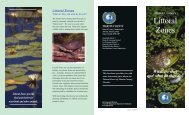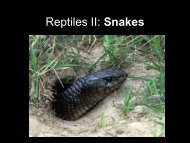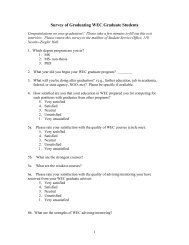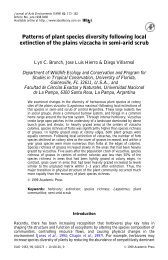The role of private lands for conservation - Wildlife Ecology and ...
The role of private lands for conservation - Wildlife Ecology and ...
The role of private lands for conservation - Wildlife Ecology and ...
Create successful ePaper yourself
Turn your PDF publications into a flip-book with our unique Google optimized e-Paper software.
<strong>The</strong> <strong>role</strong> <strong>of</strong> <strong>private</strong> <strong>l<strong>and</strong>s</strong> <strong>for</strong> <strong>conservation</strong>: L<strong>and</strong> cover change analysis<br />
in the Caldenal savanna ecosystem, Argentina<br />
Mariano González-Roglich a, *, Jane Southworth b , Lyn C. Branch c<br />
a School <strong>of</strong> Natural Resources <strong>and</strong> Environment, University <strong>of</strong> Florida, 103 Black Hall, PO Box 116455, Gainesville, FL 32611, USA<br />
b Department <strong>of</strong> Geography, L<strong>and</strong>-use <strong>and</strong> Environmental Change Institute, University <strong>of</strong> Florida, 3141 Turlington Hall, Gainesville, FL 32611, USA<br />
c Department <strong>of</strong> <strong>Wildlife</strong> <strong>Ecology</strong> <strong>and</strong> Conservation, University <strong>of</strong> Florida, Newins-Ziegler Hall, Gainesville, FL 32611, USA<br />
Keywords:<br />
L<strong>and</strong> use<br />
Cattle ranching<br />
Protected area<br />
Game reserve<br />
Fee hunting<br />
Change detection<br />
Remote sensing<br />
Introduction<br />
abstract<br />
Protected areas have been the cornerstone <strong>of</strong> <strong>conservation</strong><br />
strategies to preserve threatened ecosystems (Margules & Pressey,<br />
2000). However, degradation beyond their boundaries <strong>of</strong>ten<br />
compromises ecological objectives <strong>of</strong> protected areas (Clerici et al.,<br />
2007; Fynn & Bonyongo, 2011; Soulé & Terborgh, 1999), especially if<br />
they are small or isolated (Sanchez-Az<strong>of</strong>eifa, Rivard, Calvo, &<br />
Moorthy, 2002). A variety <strong>of</strong> mechanisms are being developed to<br />
favor <strong>conservation</strong> practices on <strong>private</strong> <strong>l<strong>and</strong>s</strong>, such as <strong>conservation</strong><br />
easements (Engel, 2007; Rissman et al., 2007; Rissman &<br />
Merenlender, 2008), payment <strong>for</strong> ecosystem services (Engel,<br />
Pagiola, & Wunder, 2008; Tallis, Kareiva, Marvier, & Chang, 2008;<br />
van der Horst, 2011), <strong>and</strong> taxes <strong>and</strong> subsidies to modify behavior<br />
(Jenkins, Scherr, & Inbar, 2004). However, in order to correctly<br />
* Corresponding author. Present address: Nicholas School <strong>of</strong> the Environment,<br />
Box 90328, Duke University, Durham, NC 27708, USA. Tel.: þ1 9196138000.<br />
E-mail address: mg136@duke.edu (M. González-Roglich).<br />
0143-6228/$ e see front matter Ó 2011 Elsevier Ltd. All rights reserved.<br />
doi:10.1016/j.apgeog.2011.12.002<br />
Applied Geography 34 (2012) 281e288<br />
Contents lists available at SciVerse ScienceDirect<br />
Applied Geography<br />
journal homepage: www.elsevier.com/locate/apgeog<br />
Protected areas are critical <strong>for</strong> <strong>conservation</strong> <strong>of</strong> the world’s biodiversity; however, parks isolated from<br />
their surroundings will not assure the maintenance <strong>of</strong> biodiversity <strong>and</strong> ecosystem integrity. Private <strong>l<strong>and</strong>s</strong><br />
have the potential to achieve the dual <strong>role</strong> <strong>of</strong> conserving natural habitats while providing goods <strong>and</strong><br />
services societies need. <strong>The</strong>re<strong>for</strong>e, underst<strong>and</strong>ing which l<strong>and</strong> use practices on <strong>private</strong> l<strong>and</strong> contribute to<br />
the maintenance <strong>of</strong> native habitats is important. In this study, a l<strong>and</strong> use <strong>and</strong> l<strong>and</strong> cover change analysis<br />
was developed <strong>for</strong> the Caldenal savanna ecosystem, Argentina, to determine the effect <strong>of</strong> <strong>private</strong> game<br />
reserves on <strong>l<strong>and</strong>s</strong>cape scale change. Game reserves were found preferentially located in the areas with<br />
highest proportion <strong>of</strong> <strong>for</strong>est cover. No differences were found in rates <strong>of</strong> conversion <strong>of</strong> native habitat to<br />
agriculture between game reserves <strong>and</strong> cattle ranches <strong>for</strong> 1987e1999 or 1999e2008. Rates <strong>of</strong> de<strong>for</strong>estation<br />
differed with l<strong>and</strong>holding size between the first <strong>and</strong> second period. De<strong>for</strong>estation stopped in the<br />
second period in the game reserves <strong>and</strong> big cattle ranches, but increased in intensity in small cattle<br />
ranches. Intensity <strong>of</strong> de<strong>for</strong>estation was more related to agricultural potential <strong>of</strong> the ranches, which are<br />
correlated with l<strong>and</strong>holding size, than to the l<strong>and</strong> use type. De<strong>for</strong>estation was higher in areas with more<br />
productive soils <strong>and</strong> higher annual rainfall. <strong>The</strong>se results suggest that, <strong>for</strong> the period analyzed, incorporation<br />
<strong>of</strong> game reserves as a l<strong>and</strong> use did not significantly alter processes <strong>of</strong> l<strong>and</strong> cover change, though<br />
if conversion to agriculture increases in marginal areas, game reserves potentially could be beneficial <strong>for</strong><br />
maintenance <strong>of</strong> a significant portion <strong>of</strong> the Caldenal.<br />
Ó 2011 Elsevier Ltd. All rights reserved.<br />
implement any <strong>of</strong> these strategies, in<strong>for</strong>mation on the <strong>conservation</strong><br />
value <strong>of</strong> different l<strong>and</strong> uses is needed.<br />
<strong>The</strong> importance <strong>of</strong> wildlife utilization as a source <strong>of</strong> income in<br />
<strong>private</strong> l<strong>and</strong>holdings has increased in recent years as an alternative<br />
to traditional rural production systems (e.g., cattle ranching),<br />
providing incentives <strong>for</strong> wildlife <strong>and</strong> habitat <strong>conservation</strong> (Butler,<br />
Teaschner, Ballard, & McGee, 2005; Williams & Lathbury, 1996).<br />
<strong>Wildlife</strong> utilization, as a l<strong>and</strong> use, has proven effective in southern<br />
Africa from an economic <strong>and</strong> biodiversity <strong>conservation</strong> perspective<br />
(Bond et al., 2004). Trophy hunting is <strong>of</strong> major importance to<br />
<strong>conservation</strong> in Africa creating economic incentives <strong>for</strong> <strong>conservation</strong><br />
over vast areas unsuitable <strong>for</strong> other activities (Lindsey, Roulet,<br />
& Romanach, 2007), although negative impacts also have been<br />
identified (Lindsey, Romanach, & Davies-Mostert, 2009; Packer<br />
et al., 2011). In North America, l<strong>and</strong>owners agree to conduct habitat<br />
enhancement activities in order to obtain hunting benefits<br />
(Williams & Lathbury, 1996), <strong>and</strong> these benefits function as an<br />
incentive <strong>for</strong> l<strong>and</strong> owners to conserve natural habitats in order to<br />
keep wildlife on their properties (Benson, 2001; Butler et al., 2005).<br />
Countries in Central <strong>and</strong> South America, particularly Argentina, are
282<br />
becoming important destinations <strong>for</strong> international sport hunting<br />
where hunters pay a fee <strong>for</strong> hunting on <strong>private</strong> l<strong>and</strong>. Fee hunting as<br />
a <strong>conservation</strong> strategy has not been evaluated in Argentina, even<br />
though <strong>private</strong> <strong>conservation</strong> initiatives are especially important in<br />
this country because most l<strong>and</strong> is <strong>private</strong>ly owned.<br />
<strong>The</strong> <strong>conservation</strong> value <strong>of</strong> different l<strong>and</strong> uses can be assessed<br />
using a variety <strong>of</strong> methods, although the method selected needs to<br />
be able to identify <strong>and</strong> quantify processes that pose a threat to the<br />
maintenance <strong>of</strong> natural ecosystems. Remote sensing is a particularly<br />
effective tool <strong>for</strong> evaluation <strong>of</strong> <strong>l<strong>and</strong>s</strong>cape scale processes<br />
(Turner et al., 2003) because it <strong>of</strong>fers an important means <strong>for</strong><br />
detecting <strong>and</strong> analyzing changes over large temporal <strong>and</strong> spatial<br />
scales (Narumalani, Mishra, & Rothwell, 2004). Remote sensing is<br />
used <strong>for</strong> analyzing consequences <strong>of</strong> <strong>l<strong>and</strong>s</strong>cape scale l<strong>and</strong> cover<br />
change <strong>of</strong> different management practices, such as regional agricultural<br />
policies (Serra, Pons, & Sauri, 2008), tourism development<br />
(Gaughan, Bin<strong>for</strong>d, & Southworth, 2009), urban development<br />
(Dewan & Yamaguchi, 2009), <strong>and</strong> establishment <strong>of</strong> protected areas<br />
(Southworth, Nagendra, Carlson, & Tucker, 2004). Use <strong>of</strong> remote<br />
sensing <strong>for</strong> determining effectiveness <strong>of</strong> protected areas is also<br />
common (e.g. Clerici et al., 2007), but we are not aware <strong>of</strong> similar<br />
studies analyzing the effect <strong>of</strong> fee hunting as a l<strong>and</strong> use on<br />
processes <strong>of</strong> l<strong>and</strong> cover change at <strong>l<strong>and</strong>s</strong>cape scales.<br />
Savannas have been identified as one <strong>of</strong> the endangered “crisis<br />
ecoregions” worldwide (Hoekstra, Boucher, Ricketts, & Roberts,<br />
2005). <strong>The</strong> Caldenal region in central Argentina is a transitional<br />
savanna ecosystem at the margin <strong>of</strong> the Pampas grass<strong>l<strong>and</strong>s</strong>, <strong>and</strong><br />
a reservoir <strong>of</strong> some <strong>of</strong> the best examples <strong>of</strong> perennial grass<strong>l<strong>and</strong>s</strong> in<br />
the country. In the last century more than 40% <strong>of</strong> its area has been<br />
converted to agriculture. In addition to on-going habitat conversion,<br />
much <strong>of</strong> the remaining Caldenal is highly degraded, where the<br />
original open savanna characterized by scattered trees <strong>and</strong> dense<br />
cover <strong>of</strong> perennial grasses (Koutche & Carmelich, 1936) has been<br />
replaced by thick thorn scrub (Lell, 2004). Moreover, currently only<br />
0.2% <strong>of</strong> this region is under <strong>for</strong>mal protection, making this system<br />
one <strong>of</strong> the highest <strong>conservation</strong> priorities <strong>for</strong> the national government<br />
<strong>of</strong> Argentina (APN, 2007).<br />
<strong>The</strong> degree to which different l<strong>and</strong> uses on <strong>private</strong> l<strong>and</strong>holdings<br />
maintain natural l<strong>and</strong> cover is critical <strong>for</strong> long term sustainability <strong>of</strong><br />
the threatened Caldenal savanna <strong>and</strong> its biodiversity because over<br />
95% <strong>of</strong> the l<strong>and</strong> is <strong>private</strong>ly owned (Gobbi, 1994). <strong>The</strong> objective <strong>of</strong><br />
this research was to assess the importance <strong>of</strong> <strong>private</strong> game reserves<br />
<strong>for</strong> <strong>conservation</strong> <strong>of</strong> native habitats in this region <strong>of</strong> central<br />
M. González-Roglich et al. / Applied Geography 34 (2012) 281e288<br />
Argentina. Processes <strong>of</strong> l<strong>and</strong> cover change were analyzed at<br />
a <strong>l<strong>and</strong>s</strong>cape scale with comparisons <strong>of</strong> l<strong>and</strong> cover composition,<br />
rates <strong>of</strong> conversion to agriculture <strong>and</strong> rates <strong>of</strong> change <strong>of</strong> naturally<br />
vegetated l<strong>and</strong> covers over time among game reserves, cattle<br />
ranches <strong>and</strong> the only protected area. Underst<strong>and</strong>ing the effect <strong>of</strong><br />
different <strong>private</strong> l<strong>and</strong> uses in the Caldenal region is critical <strong>for</strong><br />
designing a regional <strong>conservation</strong> strategy to complement the very<br />
limited protected area system with <strong>conservation</strong> <strong>of</strong> productive<br />
ecosystems on <strong>private</strong> <strong>l<strong>and</strong>s</strong>.<br />
Study area<br />
<strong>The</strong> Caldenal is a semiarid savanna ecosystem <strong>of</strong> about<br />
170,000 km 2 located in central Argentina, primarily in La Pampa<br />
province. This xerophytic open <strong>for</strong>est system is a transitional<br />
ecosystem between the Pampas grass<strong>l<strong>and</strong>s</strong>, to the east, <strong>and</strong> the dry<br />
Monte shrub<strong>l<strong>and</strong>s</strong>, to the west. It is dominated by the caldén tree<br />
(Prosopis caldenia) with understory <strong>of</strong> perennial grasses frequently<br />
interrupted by dunes, wet<strong>l<strong>and</strong>s</strong> <strong>and</strong> lagoons (Cabrera, 1994). Major<br />
changes occurred in the area with the arrival <strong>of</strong> new settlers at the<br />
end <strong>of</strong> the 19th century <strong>and</strong> have intensified since then. Replacement<br />
<strong>of</strong> natural systems with agriculture, extractive logging,<br />
introduction <strong>of</strong> non-native species, overgrazing by livestock, <strong>and</strong><br />
changes in fire regimes are the biggest threats the region has faced<br />
historically (Amieva, 1993; Medina, 2007; Mendez, 2007b).<br />
Cattle ranching is the main economic activity in the region followed<br />
by crop production (Cano, Fernández, & Montes, 1980;<br />
Mendez, 2007a); however, hunting <strong>and</strong> tourism are growing as<br />
complementary activities, occurring simultaneously in these<br />
reserves. Fee hunting is organized in <strong>private</strong> rural enterprises called<br />
game reserves (cotos de caza in Spanish). In most <strong>of</strong> these reserves<br />
cattle ranching is still the main source <strong>of</strong> income, while fee hunting<br />
is second. Game activities are focused mainly on attraction <strong>of</strong><br />
international tourists interested in hunting non-native species such<br />
as red deer (Cervus elaphus), wild boar (Sus scr<strong>of</strong>a), antelope<br />
(Antilope cervicapra) <strong>and</strong> buffalo (Bubalus bubalis) (Gobbi, 1994).<br />
<strong>The</strong>se reserves <strong>for</strong>mally began in La Pampa in 1987, <strong>and</strong> currently<br />
56 reserves are located in the Caldenal region covering over<br />
3222 km 2 (4.4% <strong>of</strong> the ecosystem in the province).<br />
<strong>The</strong> area analyzed in this project (31,000 km 2 ) is located in the<br />
central portion <strong>of</strong> the Caldenal in La Pampa province. This area was<br />
selected based on the large number <strong>of</strong> game reserves in the area<br />
(Fig. 1). <strong>The</strong> study area, <strong>and</strong> La Pampa province in general, is<br />
Fig. 1. Location <strong>of</strong> the study area, parks <strong>and</strong> game reserves in La Pampa province, Argentina.
characterized by steep northeast-southwest gradients. Rainfall<br />
decreases from 900 mm a year to 350 across only 250 km<br />
(Supplement Fig. 1). Soil types also follow the same gradient, with<br />
the most fertile soils in the northeast (Cano et al., 1980). Agrarian<br />
economic unit is the term used in local legislation to refer to the<br />
minimum amount <strong>of</strong> l<strong>and</strong> a family needs to make a living (GLP,<br />
1973). <strong>The</strong> size <strong>of</strong> these units follows the same pattern described<br />
by the natural gradients (Supplement Fig. 1). In this study, we refer<br />
to the l<strong>and</strong> owned or managed by a single person or enterprise as<br />
a l<strong>and</strong>holding, <strong>and</strong> given that management decisions are made in<br />
most cases by the direct user <strong>of</strong> the natural resource, we used the<br />
l<strong>and</strong>holding as our unit <strong>of</strong> analysis.<br />
Methods<br />
Image processing <strong>and</strong> classification<br />
L<strong>and</strong>sat 5 TM images were obtained <strong>for</strong> the end <strong>of</strong> the summer<br />
season <strong>for</strong> 1987, 1999 <strong>and</strong> 2008 (Supplement Table 1). All images<br />
were geometrically registered to a GIS layer <strong>of</strong> roads collected with<br />
a GPS during fieldwork (error < 15 m). Images were radiometrically<br />
calibrated <strong>and</strong> atmospherically corrected, converting digital<br />
numbers to surface reflectance to minimize distortion between<br />
dates allowing <strong>for</strong> more accurate time-series analysis (Green,<br />
Schweik, & R<strong>and</strong>olph, 2005). For each <strong>of</strong> the three dates, images<br />
were mosaicked to create a single image on which to per<strong>for</strong>m<br />
classification procedures.<br />
Six l<strong>and</strong> cover classes were identified: agriculture, grassl<strong>and</strong>,<br />
shrubl<strong>and</strong>, <strong>for</strong>est (following the definition from FAO, 2010, p. 378),<br />
burned, <strong>and</strong> lagoon (see Table 1 <strong>for</strong> detailed descriptions). In this<br />
document, we will refer to grassl<strong>and</strong>, shrubl<strong>and</strong> <strong>and</strong> <strong>for</strong>est as<br />
‘naturally vegetated l<strong>and</strong> covers’. <strong>The</strong> term natural is used to<br />
differentiate these areas from highly modified agricultural fields,<br />
but this should not be interpreted as areas with lack <strong>of</strong> human<br />
influence. For example, grassl<strong>and</strong> includes improved pastures as<br />
well as native grass<strong>l<strong>and</strong>s</strong>, <strong>and</strong> in some cases shrub<strong>l<strong>and</strong>s</strong> result from<br />
anthropogenic changes in grass<strong>l<strong>and</strong>s</strong> or <strong>for</strong>ests.<br />
During summer 2008, 452 training samples were collected in<br />
the field with in<strong>for</strong>mation registered on vegetation structure <strong>and</strong><br />
composition, among other variables. In addition, 234 complementary<br />
samples were extracted from high resolution imagery <strong>of</strong> the<br />
area (Google Earth). Sixty five percent <strong>of</strong> the training samples were<br />
used during the classification procedure <strong>and</strong> the remainder <strong>for</strong><br />
accuracy assessment. Different b<strong>and</strong> combinations were tried <strong>for</strong><br />
Table 1<br />
Description <strong>of</strong> l<strong>and</strong> cover classes.<br />
L<strong>and</strong> cover Description<br />
Agriculture Areas in which the l<strong>and</strong> cover resulted from direct human<br />
influence through agricultural practices. Three sub-classes<br />
composed the agriculture class: active fields, bare soil, <strong>and</strong> fallow.<br />
Grassl<strong>and</strong> Areas covered by native grass<strong>l<strong>and</strong>s</strong> <strong>and</strong> planted pastures,<br />
which could not be distinguished with imagery.<br />
Shrubl<strong>and</strong> Areas covered with woody vegetation usually having multiple<br />
stems branching from or near the ground. This class includes<br />
two different units in terms <strong>of</strong> composition <strong>and</strong> ecological<br />
characteristics. In the southwest <strong>of</strong> the study area, shrub<strong>l<strong>and</strong>s</strong><br />
are composed mainly <strong>of</strong> Larrea spp., indicating the transition<br />
between the Caldenal <strong>and</strong> the Monte ecoregions. In the rest<br />
<strong>of</strong> the study area, shrub<strong>l<strong>and</strong>s</strong> indicate sites in which caldén<br />
(the dominant tree species in the region) is present in early<br />
successional stages, both colonizing areas <strong>of</strong> grassl<strong>and</strong> or<br />
re-growing after <strong>for</strong>est fires.<br />
Forest Areas covered by at least 10 percent cover <strong>of</strong> tree crowns<br />
(FAO, 2010, p. 378).<br />
Burned: Burned areas. This includes natural <strong>and</strong> human-induced fires.<br />
Lagoon: This class includes both permanent <strong>and</strong> temporary water bodies.<br />
M. González-Roglich et al. / Applied Geography 34 (2012) 281e288 283<br />
the supervised classification procedure using the maximum likelihood<br />
classifier. <strong>The</strong> best combination in terms <strong>of</strong> separability<br />
among classes was: b<strong>and</strong>s 2, 3, 4, 5, <strong>and</strong> 7 from L<strong>and</strong>sat images,<br />
together with a digital elevation model <strong>of</strong> the area (Farr, 2007), <strong>and</strong><br />
two layers representing the X <strong>and</strong> Y coordinates. <strong>The</strong> digital<br />
elevation model <strong>and</strong> XeY coordinates incorporated in<strong>for</strong>mation in<br />
the model useful to differentiate l<strong>and</strong> cover classes that were not<br />
originally separable based on spectral data alone.<br />
<strong>The</strong> use <strong>of</strong> ancillary data has been proven to increase the<br />
accuracy <strong>of</strong> l<strong>and</strong> cover classifications (Rozenstein & Karnieli,<br />
2011). <strong>The</strong>re<strong>for</strong>e, a rule based approach, as described by<br />
Daniels (2006), was later incorporated to improve the final l<strong>and</strong><br />
cover map. Using data mining s<strong>of</strong>tware (Compumine, 2009) rules<br />
were generated <strong>and</strong> applied in ERDAS Imagine Knowledge<br />
Engineer. Rules were based on Tasseled Cap trans<strong>for</strong>mation (Crist<br />
& Kauth, 1986), normalized difference vegetation index (NDVI),<br />
<strong>and</strong> soil data <strong>of</strong> the area (soil map modified from Cano et al.,<br />
1980). Final accuracy <strong>of</strong> the classification was 88.5% (overall<br />
kappa statistics ¼ 0.85, Supplement Table 2) (Jensen, 2005). <strong>The</strong><br />
same procedure was applied to 1987 <strong>and</strong> 1999 images. Lack <strong>of</strong><br />
reference data <strong>for</strong> 1987 <strong>and</strong> 1999 prevented assessment <strong>of</strong> classification<br />
accuracies <strong>for</strong> those dates. However, given the consistency<br />
in the remote sensing data <strong>and</strong> <strong>of</strong> the classification<br />
procedure applied <strong>for</strong> 2008 <strong>and</strong> earlier years, we assumed classification<br />
accuracy did not differ significantly from that <strong>of</strong> 2008.<br />
Visual examination <strong>of</strong> the products (Supplement Figs. 2e4)<br />
supported this assumption.<br />
L<strong>and</strong>scape partitioning <strong>and</strong> analysis<br />
For analysis <strong>of</strong> processes <strong>of</strong> l<strong>and</strong> cover change <strong>and</strong> rates <strong>of</strong><br />
conversion, five l<strong>and</strong>holding types were identified: 1) Parque Luro<br />
(Park): the only protected area in Caldenal in La Pampa province<br />
(7607 ha, managed by the provincial government), 2) old game<br />
reserves: those in operation prior to March 1999; 3) new game<br />
reserves: those that have been in operation since March 1999, <strong>and</strong><br />
4) two size classes <strong>of</strong> ranches. Game reserves <strong>and</strong> the park were<br />
significantly larger than the mean size <strong>of</strong> cattle ranches<br />
(Supplement Table 3). <strong>The</strong>re<strong>for</strong>e, we split ranches into two size<br />
classes: 1) 4860 ha <strong>and</strong> larger, which is the mean size <strong>of</strong> game<br />
ranches minus one st<strong>and</strong>ard deviation <strong>and</strong> 2) smaller than 4860 ha.<br />
<strong>The</strong>n we took a r<strong>and</strong>om sample <strong>of</strong> ranches (n ¼ 40) in each <strong>of</strong> these<br />
classes to represent big <strong>and</strong> small cattle ranches, respectively.<br />
Ranches registered as game reserves in the past but not currently in<br />
operation were removed from the analysis. <strong>The</strong> l<strong>and</strong> cover change<br />
<strong>and</strong> a trajectory analysis were per<strong>for</strong>med at the l<strong>and</strong>holding level<br />
<strong>for</strong> each <strong>of</strong> the five l<strong>and</strong>holding types: Park, old game reserves, new<br />
game reserves, big cattle ranches <strong>and</strong> small cattle ranches (Fig. 2).<br />
<strong>The</strong> results <strong>for</strong> the Park are presented <strong>and</strong> discussed, however they<br />
were not included in the statistical analysis given the presence <strong>of</strong><br />
only one park in the study area.<br />
A set <strong>of</strong> rates was calculated <strong>for</strong> analyzing the effect <strong>of</strong> different<br />
l<strong>and</strong>holding types on l<strong>and</strong> cover changes. Given the importance<br />
assigned by previous studies to the processes <strong>of</strong> conversion in the<br />
area (Hoekstra et al., 2005; Mendez, 2007b), the annual gross rate<br />
<strong>of</strong> conversion <strong>of</strong> these naturally vegetated l<strong>and</strong> covers to agriculture<br />
was calculated (Dirzo & Garcia, 1992):<br />
r conversion ¼ 1 1<br />
Aconverted p<br />
Anatural t1<br />
Where Aconverted_p is the extent in hectares converted to agriculture<br />
during the period; Anatural_t1 is the extent in hectares <strong>of</strong> the naturally<br />
vegetated l<strong>and</strong> covers (grassl<strong>and</strong> þ shrubl<strong>and</strong> þ <strong>for</strong>est) at the<br />
beginning <strong>of</strong> the period; <strong>and</strong> t is the time in years. <strong>The</strong> annual rate<br />
1=t
284<br />
<strong>of</strong> change <strong>of</strong> each l<strong>and</strong> cover was computed at the l<strong>and</strong>holding level<br />
using a modified version <strong>of</strong> the <strong>for</strong>mula above:<br />
r change ¼ 1 1<br />
At1 At2 At1 1=t<br />
ð 1Þ<br />
Where At1 is the extent in hectares <strong>of</strong> the l<strong>and</strong> cover at the beginning<br />
<strong>of</strong> the period; At2 is the extent <strong>of</strong> the l<strong>and</strong> cover <strong>of</strong> interest at<br />
the end <strong>of</strong> the period; <strong>and</strong> t is the time in years <strong>for</strong> the period <strong>of</strong><br />
analysis. This rate was computed on grassl<strong>and</strong>, shrubl<strong>and</strong> <strong>and</strong> <strong>for</strong>est<br />
covers <strong>for</strong> each <strong>of</strong> the l<strong>and</strong>holdings analyzed.<br />
Given that the variables <strong>of</strong> interest did not meet the assumptions<br />
<strong>of</strong> normality, non-parametric tests were used to analyze<br />
differences among l<strong>and</strong>holding types <strong>and</strong> between periods<br />
(1987e1999, 1999e2008). In order to test <strong>for</strong> preferential establishment<br />
<strong>of</strong> game reserves in areas with higher cover <strong>of</strong> naturally<br />
vegetated l<strong>and</strong>, KruskaleWallis tests (Kruskal & Wallis, 1952) were<br />
run to test <strong>for</strong> differences in l<strong>and</strong> cover among l<strong>and</strong>holding types in<br />
1987 be<strong>for</strong>e the establishment <strong>of</strong> game reserves. Differences in<br />
rates <strong>of</strong> change <strong>of</strong> naturally vegetated l<strong>and</strong> covers <strong>and</strong> in rates <strong>of</strong><br />
conversion to agriculture were analyzed between periods <strong>for</strong> each<br />
l<strong>and</strong>holding type with Wilcoxon rank sum tests. Also, within each<br />
period, we compared rates <strong>of</strong> change <strong>and</strong> conversion <strong>of</strong> l<strong>and</strong> cover<br />
among l<strong>and</strong>holding types with KruskaleWallis tests. In all cases,<br />
l<strong>and</strong>holdings were used as replicates. When differences were<br />
significant, we per<strong>for</strong>med pairwise comparisons between l<strong>and</strong>holding<br />
types using Wilcoxon rank-sum tests, <strong>and</strong> Bonferroni<br />
corrections were applied to account <strong>for</strong> multiple comparisons<br />
(Shaffer, 1995). We also examined the relationship between rates <strong>of</strong><br />
conversion to agriculture in each period <strong>and</strong> characteristics <strong>of</strong> the<br />
l<strong>and</strong>holdings (size <strong>of</strong> individual properties, soil agricultural suitability,<br />
<strong>and</strong> average rainfall <strong>for</strong> the last 30 years) with Wilcoxon<br />
rank-sum test <strong>for</strong> categorical variables, <strong>and</strong> Spearman’s rank<br />
correlation <strong>for</strong> continuous variables.<br />
M. González-Roglich et al. / Applied Geography 34 (2012) 281e288<br />
Fig. 2. Spatial distribution <strong>of</strong> l<strong>and</strong>holdings analyzed in this study (black polygons). Background represents soil agricultural suitability (light gray ¼ suitable, dark gray ¼ unsuitable).<br />
(a) Park (n ¼ 1), (b) old game reserves (n ¼ 21), (c) new game reserves (n ¼ 38), (d) big cattle ranches (n ¼ 40), <strong>and</strong> (e) small cattle ranches (n ¼ 40).<br />
Trajectory analysis<br />
<strong>The</strong> original interest was not only to quantify net changes<br />
among classes between the dates analyzed, but to underst<strong>and</strong> the<br />
nature <strong>of</strong> the changes occurring in the area. Consequently change<br />
trajectories were examined <strong>for</strong> 1987e1999 <strong>and</strong> 1999e2008, <strong>and</strong><br />
across the 21-year period using trajectory maps (Southworth et al.,<br />
2004). Trajectory maps are built by incorporating in<strong>for</strong>mation <strong>for</strong><br />
each date in the sequence into each pixel, so we get the trajectory <strong>of</strong><br />
past l<strong>and</strong> covers, or l<strong>and</strong> cover change histories included within the<br />
pixel in<strong>for</strong>mation. As such an area that has been <strong>for</strong>ested on all<br />
dates, versus one that underwent transition across dates but is<br />
<strong>for</strong>est again by the final date e clearly are flagged with this<br />
difference in history. This allows interpreting the dynamics in l<strong>and</strong><br />
cover at the pixel level, <strong>and</strong> by aggregation at the regional level. <strong>The</strong><br />
number <strong>of</strong> possible combinations <strong>of</strong> 6 l<strong>and</strong> cover classes <strong>for</strong> the<br />
three dates (216 possible l<strong>and</strong> cover trajectories) made interpretation<br />
<strong>of</strong> trajectories cumbersome, so a more useful <strong>and</strong> intuitive<br />
hierarchical four level trajectory analysis scheme was developed to<br />
summarize changes that occurred over the 21-year period<br />
(Supplement Table 4).<br />
Results<br />
Preferential location <strong>of</strong> game reserves<br />
In 1987, be<strong>for</strong>e game reserves were <strong>for</strong>mally established, the<br />
park exhibited the highest <strong>for</strong>est cover, followed by areas used <strong>for</strong><br />
ranching that are now occupied by game reserves, <strong>and</strong> then by<br />
areas in our sample that are big cattle ranches <strong>and</strong> small cattle<br />
ranches (Fig. 3). This indicates that some <strong>of</strong> the ranches with the<br />
highest <strong>for</strong>est cover were converted to game reserves. <strong>The</strong> areas<br />
now occupied by game reserves <strong>and</strong> large cattle ranches also had<br />
Fig. 3. L<strong>and</strong> cover composition (x 1 SE) in 1987 <strong>for</strong> different l<strong>and</strong>holding types. All areas except the park were ranches in 1987. Areas labeled as game reserves currently are<br />
occupied by game reserves. Different letters within each l<strong>and</strong> cover type indicate significantly different means among l<strong>and</strong>holding types (p < 0.05).
more grassl<strong>and</strong> <strong>and</strong> shrub cover than small ranches in 1987, small<br />
cattle ranches had a much greater proportion <strong>of</strong> area in agriculture.<br />
Conversion to agriculture <strong>and</strong> rates <strong>of</strong> change<br />
Annual rates <strong>of</strong> conversion <strong>of</strong> naturally vegetated l<strong>and</strong> covers<br />
to agriculture were lower than 1% <strong>for</strong> both periods <strong>for</strong> all l<strong>and</strong>holding<br />
types except <strong>for</strong> small cattle ranches (Table 2). Differences<br />
in conversion rates between l<strong>and</strong> uses were not statistically<br />
significant <strong>for</strong> 1987e1999 or 1999e2008 (cattle ranches ¼ 4.5%,<br />
game reserves ¼ 0.8%, Wilcoxon rank sum, W ¼ 2321, p ¼ 0.8697;<br />
<strong>and</strong> cattle ranches ¼ 6.1%, game reserves ¼ 0.8%, W ¼ 2320,<br />
p ¼ 0.87 respectively). However, while rates <strong>of</strong> conversion were<br />
higher <strong>for</strong> cattle ranches in areas with suitable soils (cattle<br />
ranches ¼ 0.8%, game reserves ¼ 0.3%, Wilcoxon rank sum,<br />
W ¼ 284, p ¼ 0.14) in unsuitable areas game reserves presented<br />
higher rates <strong>of</strong> conversion to agriculture (cattle ranches ¼ 0.1%,<br />
game reserves ¼ 0.3%, Wilcoxon rank sum, W ¼ 844, p ¼ 0.10)<br />
although differences were not significant in any case. When<br />
individual l<strong>and</strong>holdings were classified as suitable or unsuitable<br />
<strong>for</strong> agriculture, regardless <strong>of</strong> the l<strong>and</strong>holding type, annual rates <strong>of</strong><br />
conversion were higher in areas with soil suitable <strong>for</strong> agriculture<br />
than areas with unsuitable soil (mean 1987e1999, suitable 7.2%,<br />
unsuitable 0.8%, Wilcoxon rank sum, W ¼ 2646, p ¼ 0.03, Fig. 4a;<br />
mean 1999e2008, suitable 9.9%, unsuitable 0.8%, W ¼ 2803,<br />
p ¼ 0.004). For game reserves, no differences in rate <strong>of</strong> conversion<br />
to agriculture were found between those located in suitable<br />
<strong>and</strong> unsuitable soils <strong>for</strong> agriculture (suitable ¼ 0.2%,<br />
unsuitable ¼ 0.3%, Wilcoxon rank sum, W ¼ 269, p ¼ 0.59), but<br />
<strong>for</strong> cattle ranches rates <strong>of</strong> conversion to agriculture were significantly<br />
higher in the more productive soils (suitable ¼ 0.8%,<br />
unsuitable ¼ 0.1%, Wilcoxon rank sum, W ¼ 1027, p ¼ 0.02). Rates<br />
<strong>of</strong> conversion to agriculture <strong>and</strong> size <strong>of</strong> individual l<strong>and</strong>holdings<br />
were negatively correlated (Spearman’s rank correlation,<br />
rho ¼ 0.18, p ¼ 0.04, Fig. 4b). <strong>The</strong> opposite relationship was<br />
found between rate <strong>of</strong> conversion <strong>and</strong> mean annual rainfall<br />
(Spearman’s rank correlation, rho ¼ 0.43, p < 0.001, Fig. 4c).<br />
Rates <strong>of</strong> change in l<strong>and</strong> cover types classified as naturally<br />
vegetated reflected processes that both remove vegetation (e.g.,<br />
agricultural conversion or fire) <strong>and</strong> increase vegetation (e.g.,<br />
natural regeneration <strong>of</strong> shrubs <strong>and</strong> trees). <strong>The</strong> amount <strong>of</strong> <strong>for</strong>est<br />
declined in all l<strong>and</strong>holding types, with the exception <strong>of</strong> the park,<br />
during 1987e1999 (Table 3). In contrast, <strong>for</strong>est cover increased<br />
during the second period on large cattle ranches <strong>and</strong> all game<br />
reserves, but declined at higher rates in small cattle ranches from<br />
1999 to 2008 than from 1987 to 1999. Rates <strong>of</strong> change in <strong>for</strong>est<br />
differed among l<strong>and</strong>holding types based on the KruskaleWallis test<br />
(1987e1999, H ¼ 9.6, d.f. ¼ 3, p ¼ 0.02; 1999e2008, H ¼ 10.1,<br />
d.f. ¼ 3, p ¼ 0.02), but the only significant pairwise difference was<br />
between big <strong>and</strong> small cattle ranches (Wilcoxon rank sum,<br />
1987e1999, W(nbig ¼ nsmall ¼ 40) ¼ 519, p ¼ 0.007; 1999e2008,<br />
W(nbig ¼ nsmall ¼ 40) ¼ 1101, p ¼ 0.004). Grass<strong>l<strong>and</strong>s</strong> <strong>and</strong> shrub<strong>l<strong>and</strong>s</strong><br />
showed no significant differences in rates <strong>of</strong> change over time <strong>for</strong><br />
any <strong>of</strong> the l<strong>and</strong>holding types, <strong>and</strong> also these l<strong>and</strong> cover types did<br />
Table 2<br />
Annual rate <strong>of</strong> conversion <strong>of</strong> naturally vegetated l<strong>and</strong> covers to agriculture (x 1 SE).<br />
L<strong>and</strong>holding type 1987e1999 1999e2008<br />
Percentage Hectares Percentage Hectares<br />
Park 0.1% ( ) 7.2 ( ) 0.3% ( ) 20.6 ( )<br />
Old game reserves 0.6% ( 0.2) 32.0 ( 11.1) 0.5% ( 0.2) 24.9 ( 7.9)<br />
New game reserves 0.9% ( 0.2) 28.7 ( 13.1) 0.9% ( 0.1) 24.0 ( 4.3)<br />
Big cattle ranches 0.7% ( 0.2) 27.6 ( 6.1) 0.7% ( 0.2) 30.5 ( 6.3)<br />
Small cattle ranches 8.4% ( 2.6) 3.7 ( 1.2) 11.6% ( 3.6) 3.6 ( 0.8)<br />
M. González-Roglich et al. / Applied Geography 34 (2012) 281e288 285<br />
not differ significantly among l<strong>and</strong>holding types <strong>for</strong> either period <strong>of</strong><br />
analysis (all H 4.07, d.f. ¼ 3, p 0.25).<br />
Trajectory analysis<br />
<strong>The</strong> trajectory analysis showed that the majority <strong>of</strong> l<strong>and</strong> cover<br />
did not change across dates (Supplement Fig. 5a). For all the<br />
l<strong>and</strong>holdings analyzed, most changes that occurred during the 21year<br />
period were not agricultural conversion (on average 77% <strong>of</strong> the<br />
changed surface, Supplement Fig. 5c). In game reserves <strong>and</strong> cattle<br />
ranches, an increase in shrub cover was the main change observed<br />
(Supplement Fig. 5e). This occurred via two processes: 1) conversion<br />
<strong>of</strong> <strong>for</strong>est to shrub<strong>l<strong>and</strong>s</strong> through logging <strong>and</strong> burning, which<br />
was distributed throughout the study area with no clear spatial<br />
pattern; <strong>and</strong> 2) invasion <strong>of</strong> grass<strong>l<strong>and</strong>s</strong> by shrubs, mainly in the<br />
western sector <strong>of</strong> the study area. Conversion to agriculture represented<br />
on average 15% <strong>of</strong> the changed area, <strong>and</strong> conversion <strong>of</strong><br />
agricultural fields to other l<strong>and</strong> covers only comprised 8% <strong>of</strong> the<br />
changed area (Supplement Fig. 5c). <strong>The</strong> trajectory analysis did not<br />
identify clear differences in the pattern <strong>of</strong> l<strong>and</strong> cover change<br />
between game reserves <strong>and</strong> cattle ranches <strong>for</strong> the period analyzed.<br />
Discussion<br />
Processes <strong>of</strong> l<strong>and</strong> cover change<br />
In our study region, game reserves initially were established in<br />
areas where <strong>for</strong>est cover was more abundant, <strong>and</strong> <strong>for</strong> the last 21<br />
years game reserves have continued to maintain <strong>for</strong>est cover. This<br />
preferential selection <strong>of</strong> <strong>for</strong>est <strong>for</strong> game reserves may be explained<br />
by the high abundance <strong>of</strong> non-native game species, especially red<br />
deer (C. elaphus) in <strong>for</strong>ested habitats <strong>of</strong> La Pampa. This species was<br />
introduced from Europe into the Caldenal savanna <strong>for</strong>ests <strong>of</strong><br />
Argentina <strong>for</strong> hunting in the first decade <strong>of</strong> the 20th century <strong>and</strong><br />
remains the primary game species in the region. <strong>The</strong> fact that game<br />
reserves have been established preferentially in areas where one <strong>of</strong><br />
the habitats <strong>of</strong> greatest <strong>conservation</strong> interest is located is significant<br />
<strong>and</strong> should be considered in regional <strong>conservation</strong> planning.<br />
Rates <strong>of</strong> conversion <strong>of</strong> naturally vegetated l<strong>and</strong> covers to agriculture<br />
were expected to be lower in areas where game reserves<br />
were established as compared to cattle ranches. However, no such<br />
differences were found. Conversion rates <strong>for</strong> both large cattle<br />
ranches <strong>and</strong> game reserves were small (
286<br />
(73%). Forest loss in La Pampa is occurring most rapidly to the east,<br />
where environmental conditions are more appropriate <strong>for</strong> development<br />
<strong>of</strong> agriculture. <strong>The</strong>se results rein<strong>for</strong>ce the idea <strong>of</strong> the<br />
presence <strong>of</strong> an active agricultural frontier to the east <strong>of</strong> the Caldenal<br />
(Lell, 2004). Pressure from agriculture, <strong>and</strong> consequently conversion,<br />
is lower the farther west the property is located, regardless <strong>of</strong><br />
establishment <strong>of</strong> game reserves. <strong>The</strong>se results indicate that it is not<br />
the l<strong>and</strong> use, but the presence <strong>of</strong> more appropriate environmental<br />
conditions, particularly good soils <strong>and</strong> water availability, that are<br />
influencing processes <strong>of</strong> l<strong>and</strong> cover change in the area. Currently,<br />
game reserves <strong>and</strong> large cattle ranches are not suffering from <strong>for</strong>est<br />
loss. However, if new crops or more efficient farming techniques<br />
were developed <strong>for</strong> the drier environmental conditions <strong>of</strong> the west,<br />
the remainder <strong>of</strong> the Caldenal may follow the same conversion path<br />
as has occurred in the eastern agricultural region.<br />
In the Caldenal region fires kill above ground parts <strong>of</strong> trees <strong>and</strong><br />
shrubs, but when fuel loads are not high, below-ground parts <strong>of</strong><br />
these woody plants <strong>of</strong>ten survive <strong>and</strong> vigorous resprouting occurs<br />
(Boo, Pelaez, Bunting, Mayor, & Elia, 1997). Studies in the region<br />
have shown that after cattle were introduced Caldén recruitment<br />
increased significantly (Dussart, Lerner, & Peinetti, 1998). Cattle also<br />
promotes persistence <strong>of</strong> woody species, through an increase in<br />
germination <strong>and</strong> establishment <strong>of</strong> Caldén seedlings <strong>and</strong> a reduction<br />
in woody plant mortality due to reduced fuel loads (Villalobos,<br />
Pelaez, & Elia, 2005). Introduction <strong>of</strong> cattle <strong>and</strong> altered fire<br />
regimes in the last century have generated an increase in the shrub<br />
cover to the detriment <strong>of</strong> natural grass<strong>l<strong>and</strong>s</strong> <strong>and</strong> open <strong>for</strong>ests<br />
(Busso, 1997).<br />
Remote sensing applications <strong>of</strong>fer a very cost effective <strong>and</strong><br />
objective means to characterize l<strong>and</strong> cover over large areas;<br />
however, these applications also have their limitations. In this<br />
study in particular, we were not able to differentiate between<br />
natural grass<strong>l<strong>and</strong>s</strong> <strong>and</strong> improved pastures, a limitation that could<br />
have significant implications <strong>for</strong> the assessment <strong>of</strong> the final<br />
<strong>conservation</strong> value <strong>of</strong> the l<strong>and</strong> use types analyzed. <strong>The</strong> improvement<br />
<strong>of</strong> pastures with an introduced grass, Ergrostis curvula, is<br />
a very common practice in the area, <strong>and</strong> even though in these<br />
pastures the abundance <strong>and</strong> diversity <strong>of</strong> native species increases<br />
over time (there are E. corvula pastures over 20 years old), they will<br />
remain dominated by this introduced species. Moreover, results <strong>of</strong><br />
Table 3<br />
Annual rate <strong>of</strong> change <strong>of</strong> natural l<strong>and</strong> cover classes (x 1 SE).<br />
M. González-Roglich et al. / Applied Geography 34 (2012) 281e288<br />
Fig. 4. Relationship between the rate <strong>of</strong> conversion <strong>of</strong> naturally vegetated l<strong>and</strong> covers to agriculture from 1987 to 1999 <strong>and</strong> characteristics <strong>of</strong> the l<strong>and</strong>holding (n ¼ 139). <strong>The</strong> same<br />
patterns were observed from 1999 to 2008.<br />
surveys developed to underst<strong>and</strong> management differences<br />
between cattle ranches <strong>and</strong> game reserves showed that, although<br />
only 15% <strong>of</strong> the ranches planted pastures, over 80% <strong>of</strong> the game<br />
reserves did (Gonzalez Roglich, unpub.). A more detailed remote<br />
sensing analysis (e.g., including phenology differentiation) or<br />
intensive field campaigns would allow <strong>for</strong> a more complete<br />
underst<strong>and</strong>ing <strong>of</strong> the effect <strong>of</strong> game reserves <strong>of</strong> native grassl<strong>and</strong><br />
<strong>conservation</strong>.<br />
Game reserves <strong>and</strong> <strong>conservation</strong><br />
Game reserves have been identified as l<strong>and</strong> use types with high<br />
<strong>conservation</strong> value given their relatively low impact on local<br />
natural resources <strong>and</strong> their high pr<strong>of</strong>itability, particularly in Africa<br />
<strong>and</strong> North America (Barnes & deJager, 1996; Lindsey, Alex<strong>and</strong>er,<br />
Frank, Mathieson, & Romanach, 2006; Tomlinson, Hearne, &<br />
Alex<strong>and</strong>er, 2002). However in Argentina, fee hunting in game<br />
reserves is a relatively new activity, <strong>and</strong> the benefits <strong>of</strong> these<br />
activities <strong>for</strong> the <strong>conservation</strong> <strong>of</strong> native ecosystems have not been<br />
assessed previously. Our results show that game reserves in central<br />
Argentina have been established in the areas <strong>of</strong> highest <strong>for</strong>est cover,<br />
which potentially could be very beneficial <strong>for</strong> <strong>conservation</strong> in<br />
a <strong>l<strong>and</strong>s</strong>cape that has suffered high rates <strong>of</strong> de<strong>for</strong>estation. Because<br />
de<strong>for</strong>estation is occurring primarily to the east <strong>of</strong> the game<br />
reserves, these reserves are not currently playing a <strong>role</strong> in reducing<br />
de<strong>for</strong>estation. Nonetheless, because <strong>of</strong> the prime habitat on most <strong>of</strong><br />
these reserves (i.e., <strong>for</strong>est <strong>and</strong> native grassl<strong>and</strong>), with appropriate<br />
management, these reserves could greatly benefit native flora <strong>and</strong><br />
fauna, <strong>and</strong> conserve key ecological processes in native ecosystems.<br />
However, the focus on non-native species in hunting enterprises<br />
in Argentina likely reduces the <strong>conservation</strong> value <strong>of</strong> this l<strong>and</strong> use.<br />
Introduced species are one <strong>of</strong> the greatest threats to <strong>conservation</strong> <strong>of</strong><br />
biodiversity worldwide (Butchart et al., 2010). If game reserves in<br />
the Caldenal promote increases in populations <strong>of</strong> non-native<br />
species or continue to actively introduce new species <strong>for</strong> hunting,<br />
they could generate negative impacts precisely in areas where the<br />
habitat <strong>of</strong> greatest <strong>conservation</strong> interest is located. Extensive<br />
research is needed to determine how to manage these introduced<br />
species to reduce impacts on native ecosystems, <strong>and</strong> long term<br />
research <strong>and</strong> monitoring are required to determine if<br />
L<strong>and</strong>holding type Grassl<strong>and</strong> Shrubl<strong>and</strong> Forest<br />
1987e1999 1999e2008 1987e1999 1999e2008 1987e1999 1999e2008<br />
Park 3.9% (e) 1.8% (e) 0.0% (e) 0.0% (-) 0.3% (e) 0.2% (e)<br />
Old game reserves 1.8% ( 5.3) 1.8% ( 2.5) 6.3% ( 9.7) 0.1% ( 3.5) 5.1% ( 1.5) 0.7% ( 4.5)<br />
New game reserves 1.3% ( 1.5) 2.7% ( 2.4) 1.8% ( 3.8) 5.9% ( 3.1) 3.6% ( 1.2) 2.3% ( 1.7)<br />
Big cattle ranches 2.7% ( 3.7) 1.9% ( 1.7) 9.7% ( 5.9) 6.9% ( 3.0) 4.7% ( 1.5) 4.6% ( 2.0)<br />
Small cattle ranches 6.7% ( 4.7) 11.8% ( 6.1) 5.2% ( 4.5) 2.7% ( 3.2) 2.1% ( 4.0) 11.5% ( 4.4)
intensification in l<strong>and</strong> cover conversion occurs in the area <strong>of</strong> game<br />
reserves <strong>and</strong> whether game reserves will play a <strong>role</strong> in preventing<br />
the conversion.<br />
Conclusion<br />
<strong>The</strong> net <strong>conservation</strong> value <strong>of</strong> <strong>private</strong> game reserves in central<br />
Argentina is not clear. Establishment <strong>of</strong> these reserves in the areas<br />
with the highest <strong>for</strong>est cover may make them valuable. However,<br />
given their location in the areas <strong>of</strong> current low pressure <strong>of</strong> conversion<br />
to agriculture, to date they have not affected the processes <strong>of</strong><br />
l<strong>and</strong> cover change. In addition, game reserves have introduced new<br />
threats to the system in the <strong>for</strong>m <strong>of</strong> new <strong>and</strong> abundant non-native<br />
species <strong>for</strong> fee hunting. <strong>The</strong> real contribution <strong>of</strong> <strong>private</strong> game<br />
reserves to the <strong>conservation</strong> <strong>of</strong> the Caldenal region in central<br />
Argentina can only be assessed with further monitoring <strong>of</strong> l<strong>and</strong><br />
cover change <strong>and</strong> research on effects <strong>of</strong> introduced species on the<br />
native biodiversity <strong>and</strong> ecosystem functioning <strong>of</strong> the Caldenal.<br />
Acknowledgments<br />
This research was supported by the Fulbright Program, Research<br />
Fellowship Program <strong>of</strong> the <strong>Wildlife</strong> Conservation Society, Tropical<br />
Conservation <strong>and</strong> Development Program (UF), La Pampa Natural<br />
Resources Agency, La Pampa <strong>Ecology</strong> Agency, <strong>and</strong> La Pampa<br />
Emergency Management Agency. <strong>The</strong> following individuals played<br />
a significant <strong>role</strong> in this study: B. Child, M. Betelu, M. Urioste, F.<br />
Titarelli, G. Romero, D. Villarreal, E. Estanga-Mollica, M. Castro, M.<br />
Casanovas, Y. Rubio <strong>and</strong> E. Cadena. Field assistants M. Cock <strong>and</strong> J.<br />
Lagos deserve special recognition <strong>for</strong> all their hard work.<br />
Appendix. Supplementary data<br />
Supplementary data associated with this article can be found, in<br />
the online version, at doi:10.1016/j.apgeog.2011.12.002.<br />
References<br />
Amieva, E. O. (1993). El Parque Luro. Santa Rosa: Fondo Editorial Pampeano.<br />
APN. (2007). Las areas protegidas de la Argentina, herramienta superior para la conservacion<br />
de nuestro patrimonio natural y cultural. Buenos Aires: Administracion<br />
de Parque Nacionales.<br />
Barnes, J. I., & deJager, J. L. V. (1996). Economic <strong>and</strong> financial incentives <strong>for</strong> wildlife<br />
use on <strong>private</strong> l<strong>and</strong> in Namibia <strong>and</strong> the implications <strong>for</strong> policy. South African<br />
Journal <strong>of</strong> <strong>Wildlife</strong> Research, 26(2), 37e46.<br />
Benson, D. E. (2001). <strong>Wildlife</strong> <strong>and</strong> recreation management on <strong>private</strong> <strong>l<strong>and</strong>s</strong> in the<br />
United States. <strong>Wildlife</strong> Society Bulletin, 29(1), 359e371.<br />
Bond, I., Child, B., de la Harpe, D., Jones, B., Barnes, J., & Anderson, H. (2004). Private<br />
l<strong>and</strong> contribution to <strong>conservation</strong> is southern Africa. In B. Child (Ed.), Parks in<br />
transition (pp. 267). London: Earthscan.<br />
Boo, R. M., Pelaez, D. V., Bunting, S. C., Mayor, M. D., & Elia, O. R. (1997). Effect <strong>of</strong> fire<br />
on woody species in central semi-arid Argentina. Journal <strong>of</strong> Arid Environments,<br />
35(1), 87e94.<br />
Busso, C. A. (1997). Towards an increased <strong>and</strong> sustainable production in semi-arid<br />
range<strong>l<strong>and</strong>s</strong> <strong>of</strong> central Argentina: two decades <strong>of</strong> research. Journal <strong>of</strong> Arid Environments,<br />
36, 197e210.<br />
Butchart, S. H. M., Walpole, M., Collen, B., van Strien, A., Scharlemann, J. P. W.,<br />
Almond, R. E. A., et al. (2010). Global biodiversity: indicators <strong>of</strong> recent declines.<br />
Science, 328(5982), 1164e1168.<br />
Butler, M. J., Teaschner, A. P., Ballard, W. B., & McGee, B. K. (2005). Commentary:<br />
wildlife ranching in North Americaearguments, issues, <strong>and</strong> perspectives.<br />
<strong>Wildlife</strong> Society Bulletin, 33(1), 381e389.<br />
Cabrera, A. L. (1994). Enciclopedia Argentina de agricultura y jardinería, Tomo II,<br />
Fascículo 1: Regiones fitogeográficas Argentinas. Buenos Aires: Acme.<br />
Cano, E., Fernández, B., & Montes, A. (1980). Inventario integrado de los recursos<br />
naturales de la provincia de La Pampa. Buenos Aires: UNLPam, Gobierno de La<br />
Pampa e INTA.<br />
Clerici, N., Bodini, A., Eva, H., Gregoire, J. M., Dulieu, D., & Paolini, C. (2007).<br />
Increased isolation <strong>of</strong> two biosphere reserves <strong>and</strong> surrounding protected areas<br />
(WAP ecological complex, West Africa). Journal <strong>for</strong> Nature Conservation, 15(1),<br />
26e40.<br />
Compumine. (2009). Compumine, rule discovery system. http://www.compumine.<br />
com.<br />
M. González-Roglich et al. / Applied Geography 34 (2012) 281e288 287<br />
Crist, E. P., & Kauth, R. J. (1986). <strong>The</strong> tasseled cap de-mystified. Photogrammetric<br />
Engineering <strong>and</strong> Remote Sensing, 52(1), 81e86.<br />
Daniels, A. E. (2006). Incorporating domain knowledge <strong>and</strong> spatial relationships<br />
into l<strong>and</strong> cover classifications: a rule-based approach. International Journal <strong>of</strong><br />
Remote Sensing, 27(14), 2949e2975.<br />
Dewan, A. M., & Yamaguchi, Y. (2009). L<strong>and</strong> use <strong>and</strong> l<strong>and</strong> cover change in Greater<br />
Dhaka, Bangladesh: using remote sensing to promote sustainable urbanization.<br />
Applied Geography, 29(3), 390e401.<br />
Dirzo, R., & Garcia, M. C. (1992). Rates <strong>of</strong> de<strong>for</strong>estation in Los Tuxlas, a neotropical<br />
are in southeast Mexico. Conservation Biology, 6(1), 84e90.<br />
Dussart, E., Lerner, P., & Peinetti, R. (1998). Long term dynamics <strong>of</strong> 2 populations<br />
<strong>of</strong> Prosopis caldenia Burkart. Journal <strong>of</strong> Range Management, 51(6),<br />
685e691.<br />
Engel, J. B. (2007). <strong>The</strong> development, status, <strong>and</strong> viability <strong>of</strong> the <strong>conservation</strong><br />
easement as a <strong>private</strong> l<strong>and</strong> <strong>conservation</strong> tool in the Western United-States.<br />
Urban Lawyer, 39(1), 19e74.<br />
Engel, S., Pagiola, S., & Wunder, S. (2008). Designing payments <strong>for</strong> environmental<br />
services in theory <strong>and</strong> practice: an overview <strong>of</strong> the issues. Ecological Economics,<br />
65(4), 663e674.<br />
FAO. (2010). Global <strong>for</strong>est resources assessment 2010. Main Report. Rome.<br />
Farr, T. G. (2007). <strong>The</strong> shuttle radar topography mission. Reviews <strong>of</strong> Geophysics, 45.<br />
Fynn, R. W. S., & Bonyongo, M. C. (2011). Functional <strong>conservation</strong> areas <strong>and</strong> the<br />
future <strong>of</strong> Africa’s wildlife. African Journal <strong>of</strong> <strong>Ecology</strong>, 49(2), 175e188.<br />
Gaughan, A. E., Bin<strong>for</strong>d, M. W., & Southworth, J. (2009). Tourism, <strong>for</strong>est conversion,<br />
<strong>and</strong> l<strong>and</strong> trans<strong>for</strong>mations in the Angkor basin, Cambodia. Applied Geography,<br />
29(2), 212e223.<br />
GLP. (1973). Gobierno de La Pampa. Ley 468: Fij<strong>and</strong>o normas para el fracionamiento de<br />
predios rurales. http://www.catastro.lapampa.gov.ar/Legislacion/Pdf/Leyes/<br />
Ley468.pdf.<br />
Gobbi, J. A. (1994). Coto de caza activity in La Pampa province, Argentina. Unpublished<br />
Master <strong>of</strong> Arts thesis, Gainesville: University <strong>of</strong> Florida.<br />
Green, G. M., Schweik, C. M., & R<strong>and</strong>olph, J. C. (2005). Retrieving l<strong>and</strong>-cover change<br />
in<strong>for</strong>mation from <strong>l<strong>and</strong>s</strong>at satellite images by minimizing other sources <strong>of</strong><br />
reflectance variability. In E. F. Moran, & E. Ostrom (Eds.), Seeing the <strong>for</strong>est <strong>and</strong> the<br />
trees (pp. 442). Cambridge: <strong>The</strong> MIT Press.<br />
Hoekstra, J. M., Boucher, T. M., Ricketts, T. H., & Roberts, C. (2005). Confronting<br />
a biome crisis: global disparities <strong>of</strong> habitat loss <strong>and</strong> protection. <strong>Ecology</strong> Letters,<br />
8(1), 23e29.<br />
van der Horst, D. (2011). Adoption <strong>of</strong> payments <strong>for</strong> ecosystem services: an application<br />
<strong>of</strong> the Hagerstr<strong>and</strong> model. Applied Geography, 31(2), 668e676.<br />
Jenkins, M., Scherr, S. J., & Inbar, M. (2004). Markets <strong>for</strong> biodiversity services -<br />
potential <strong>role</strong>s <strong>and</strong> challenges. Environment, 46(6), 32e42.<br />
Jensen, J. R. (2005). Introductory digital image processing: A remote sensing<br />
perspective (3rd ed.). Upper Saddle River: Pearson Prentice Hall.<br />
Koutche, V., & Carmelich, J. (1936). Estudio <strong>for</strong>estal del caldén. Boletin del Ministerio<br />
de Agricultura de la Nacion, XXXVII(1e4), 1e22.<br />
Kruskal, W. H., & Wallis, W. A. (1952). Use <strong>of</strong> ranks in one-criterion variance<br />
analysis. Journal <strong>of</strong> the American Statistical Association, 47(260), 583e621.<br />
Lell, J. D. (2004). El Caldenal: una visión panorámica del mismo enfatiz<strong>and</strong>o en su<br />
uso. In M. F. Arturi, J. L. Frangi, & J. F. Goya (Eds.), Ecología y manejo de los<br />
bosques de Argentina (pp. 18).<br />
Lindsey, P. A., Alex<strong>and</strong>er, R., Frank, L. G., Mathieson, A., & Romanach, S. S. (2006).<br />
Potential <strong>of</strong> trophy hunting to create incentives <strong>for</strong> wildlife <strong>conservation</strong> in<br />
Africa where alternative wildlife-based l<strong>and</strong> uses may not be viable. Animal<br />
Conservation, 9(3), 283e291.<br />
Lindsey, P. A., Romanach, S. S., & Davies-Mostert, H. T. (2009). <strong>The</strong> importance <strong>of</strong><br />
conservancies <strong>for</strong> enhancing the value <strong>of</strong> game ranch l<strong>and</strong> <strong>for</strong> large mammal<br />
<strong>conservation</strong> in southern Africa. Journal <strong>of</strong> Zoology, 277(2), 99e105.<br />
Lindsey, P. A., Roulet, P. A., & Romanach, S. S. (2007). Economic <strong>and</strong> <strong>conservation</strong><br />
significance <strong>of</strong> the trophy hunting industry in sub-Saharan Africa. Biological<br />
Conservation, 134(4), 455e469.<br />
Margules, C. R., & Pressey, R. L. (2000). Systematic <strong>conservation</strong> planning. Nature,<br />
405(6783), 243e253.<br />
Medina, A. A. (2007). Reconstrucción de los regímenes de fuego en un bosque<br />
de Prosopis caldenia, provincia de La Pampa, Argentina. Bosque, 28(3),<br />
234e240.<br />
Mendez, J. L. (2007a). Primer inventario nacional de bosques nativos. Segunda etapa,<br />
inventario de campo de la región del Espinal: Distritos del Caldén y Ñ<strong>and</strong>ubay.<br />
Buenos Aires: Dirección nacional de bosques.<br />
Mendez, J. L. (2007b). Primer inventario nacional de bosques nativos. Segunda etapa,<br />
inventario de campo de la región del espinal: Distritos del Caldén y Ñ<strong>and</strong>ubay.<br />
Anexo 1: Estado de conservación del Caldenal. Buenos Aires: Dirección nacional<br />
de bosques.<br />
Narumalani, S., Mishra, D. R., & Rothwell, R. G. (2004). Change detection <strong>and</strong><br />
<strong>l<strong>and</strong>s</strong>cape metrics <strong>for</strong> inferring anthropogenic processes in the greater EFMO<br />
area. Remote Sensing <strong>of</strong> Environment, 91(3e4), 478e489.<br />
Packer, C., Brink, H., Kissui, B. M., Maliti, H., Kushnir, H., & Caro, T. (2011). Effects <strong>of</strong><br />
trophy hunting on lion <strong>and</strong> leopard populations in Tanzania. Conservation<br />
Biology, 25(1), 142e153.<br />
Rissman, A. R., Lozier, L., Comendant, T., Kareiva, P., Kiesecker, J. M., Shaw, M. R.,<br />
et al. (2007). Conservation easements: biodiversity protection <strong>and</strong> <strong>private</strong> use.<br />
Conservation Biology, 21(3), 709e718.<br />
Rissman, A. R., & Merenlender, A. M. (2008). <strong>The</strong> <strong>conservation</strong> contributions <strong>of</strong><br />
<strong>conservation</strong> easements: analysis <strong>of</strong> the San Francisco Bay area protected <strong>l<strong>and</strong>s</strong><br />
spatial Database. <strong>Ecology</strong> <strong>and</strong> Society, 13(1), 25.
288<br />
Rozenstein, O., & Karnieli, A. (2011). Comparison <strong>of</strong> methods <strong>for</strong> l<strong>and</strong>-use classification<br />
incorporating remote sensing <strong>and</strong> GIS inputs. Applied Geography, 31(2),<br />
533e544.<br />
Sanchez-Az<strong>of</strong>eifa, G. A., Rivard, B., Calvo, J., & Moorthy, I. (2002). Dynamics <strong>of</strong> tropical<br />
de<strong>for</strong>estation around national parks: remote sensing <strong>of</strong> <strong>for</strong>est change on the Osa<br />
peninsula <strong>of</strong> Costa Rica. Mountain Research <strong>and</strong> Development, 22(4), 352e358.<br />
Serra, P., Pons, X., & Sauri, D. (2008). L<strong>and</strong>-cover <strong>and</strong> l<strong>and</strong>-use change in a Mediterranean<br />
<strong>l<strong>and</strong>s</strong>cape: a spatial analysis <strong>of</strong> driving <strong>for</strong>ces integrating biophysical<br />
<strong>and</strong> human factors. Applied Geography, 28(3), 189e209.<br />
Shaffer, J. P. (1995). Multiple hypothesis testing. Annual Review <strong>of</strong> Psychology, 46,<br />
561e584.<br />
Soulé, M. E., & Terborgh, J. (1999). Conserving nature at regional <strong>and</strong> continental<br />
scales - a scientific program <strong>for</strong> North America. Bioscience, 49(10), 809e817.<br />
Southworth, J., Nagendra, H., Carlson, L. A., & Tucker, C. (2004). Assessing the impact<br />
<strong>of</strong> Celaque national park on <strong>for</strong>est fragmentation in western Honduras. Applied<br />
Geography, 24(4), 303e322.<br />
M. González-Roglich et al. / Applied Geography 34 (2012) 281e288<br />
Tallis, H., Kareiva, P., Marvier, M., & Chang, A. (2008). An ecosystem services<br />
framework to support both practical <strong>conservation</strong> <strong>and</strong> economic development.<br />
Proceedings <strong>of</strong> the National Academy <strong>of</strong> Sciences <strong>of</strong> the United States <strong>of</strong> America,<br />
105(28), 9457e9464.<br />
Tomlinson, K. W., Hearne, J. W., & Alex<strong>and</strong>er, R. R. (2002). An approach to evaluate<br />
the effect <strong>of</strong> property size on l<strong>and</strong>-use options in semi-arid range<strong>l<strong>and</strong>s</strong>.<br />
Ecological Modelling, 149, 85e95.<br />
Turner, W., Spector, S., Gardiner, N., Fladel<strong>and</strong>, M., Sterling, E., & Steiniger, M. (2003).<br />
Remote sensing <strong>for</strong> biodiversity science <strong>and</strong> <strong>conservation</strong>. TRENDS in <strong>Ecology</strong><br />
<strong>and</strong> Evolution, 18(6), 306e314.<br />
Villalobos, A. E. d., Pelaez, D. V., & Elia, O. R. (2005). Growth <strong>of</strong> Prosopis caldenia<br />
Burk: seedlings in central semi-arid range<strong>l<strong>and</strong>s</strong> <strong>of</strong> Argentina. Journal <strong>of</strong> Arid<br />
Environments, 61, 345e356.<br />
Williams, C. E., & Lathbury, M. E. (1996). Economic incentives <strong>for</strong> habitat <strong>conservation</strong><br />
on <strong>private</strong> l<strong>and</strong>: applications to the Inl<strong>and</strong> Pacific Northwest. <strong>Wildlife</strong><br />
Society Bulletin, 24(2), 187e191.


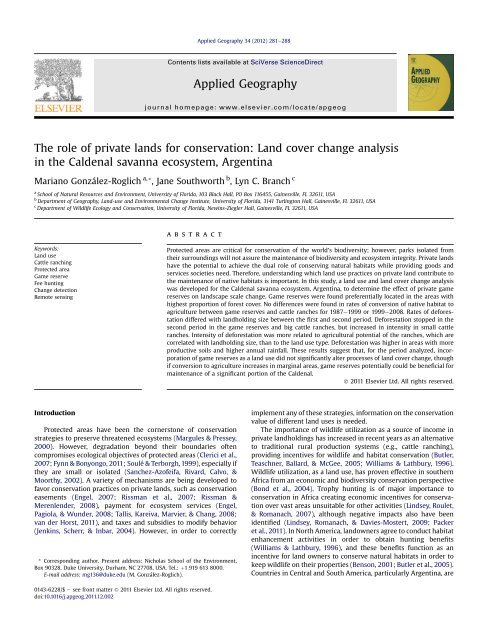
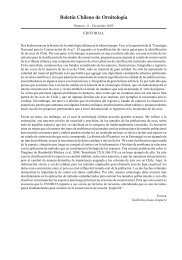
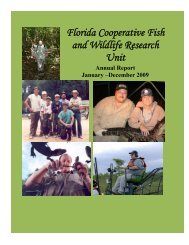
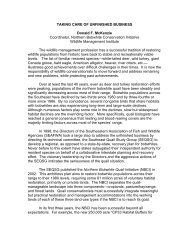
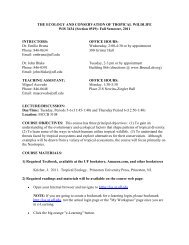
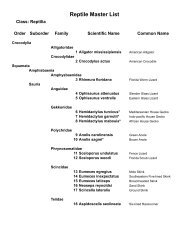

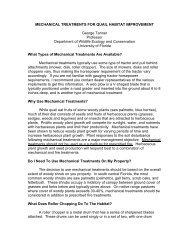
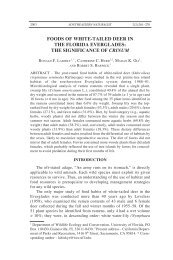
![rivers,lakes.ppt [Read-Only]](https://img.yumpu.com/43445703/1/190x245/riverslakesppt-read-only.jpg?quality=85)
